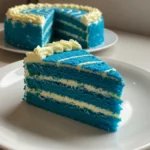Storing cake properly is essential to maintain its freshness, moisture, and flavor. Whether you’re a professional baker or a home enthusiast, understanding the best practices for cake storage can make a significant difference. In this article, we’ll explore effective cake storage hacks, answer common questions, and provide tips to ensure your cakes remain delightful from the first slice to the last.
Table of Contents
Table of Contents
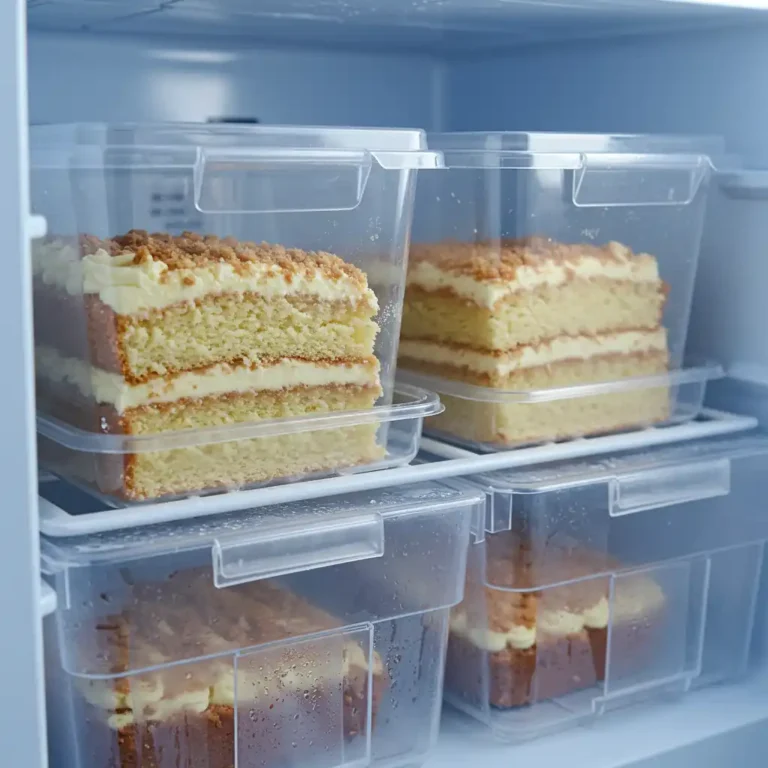
Cake Storage Hacks: Expert Tips to Keep Your Cakes Fresh and Moist
Say goodbye to dry and crumbly cakes! Discover smart, easy, and expert-approved hacks to keep your cakes perfectly moist and fresh—whether you’re storing them overnight, for a few days, or freezing them for later. These tips work for frosted, unfrosted, layered, or sliced cakes.
- Total Time: 10 minutes
- Yield: Applicable to 1 whole cake or multiple slices
Ingredients
(Since this is a storage tips post, this section is adapted to essential tools/materials you’ll need.)
Plastic wrap or cling film
Aluminum foil
Airtight cake containers or domes
Ziplock freezer bags (for slices)
Parchment or wax paper
Cake box (for transportation)
Cake board (for layering/foundation)
Instructions
Step 1: Let Cake Cool Completely
Before wrapping or storing, always allow your cake to cool to room temperature to avoid sogginess caused by trapped steam.
Step 2: Choose Based on Type
Unfrosted Cakes: Wrap tightly in plastic wrap, then foil.
Frosted Cakes: Chill for 15-30 minutes until frosting sets, then cover loosely with plastic or use a cake dome.
Sliced Cakes: Press a piece of plastic wrap against each exposed slice or store in airtight containers.
Step 3: Refrigeration Guidelines
Short-Term (1–3 days): Keep in an airtight container in the fridge.
Note: Refrigeration can dry cake—bring it to room temp before serving.
Step 4: Freezing for Later
Wrap unfrosted or frosted cake layers in plastic + foil.
Store in freezer-safe bags or containers.
Label with date; consume within 2–3 months for best results.
Step 5: Thawing
Thaw overnight in the fridge or on the counter for a few hours.
Avoid unwrapping until fully thawed to prevent condensation from ruining the texture.
Notes
Add a slice of bread inside the container to absorb moisture and keep cake moist.
Use parchment between cake layers for easy separation during freezing.
Avoid storing cakes in direct sunlight or near heat.
Don’t refrigerate fondant-covered cakes unless absolutely necessary.
- Prep Time: 10 minutes
- Cook Time: 0 minutes
- Category: How-To / Baking Tips
- Method: Storage & Preservation
- Cuisine: Universal
Nutrition
- Serving Size: 1 slice (if applicable)
- Calories: 350
- Sugar: 28g
- Sodium: 180mg
- Fat: 16g
- Saturated Fat: 8g
- Unsaturated Fat: 7g
- Trans Fat: 0g
- Carbohydrates: 45g
- Fiber: 2g
- Protein: 4g
- Cholesterol: 35mg
Understanding Cake Storage Essentials
Why Proper Cake Storage Matters
When it comes to cake storage hacks, the first and most important step is understanding why storage matters in the first place. A freshly baked cake is soft, moist, and full of flavor. But leave it uncovered on the counter overnight, and by morning, it can turn dry, stale, or even spoil. That’s a baker’s nightmare.
Whether you’re dealing with a delicate chiffon, a rich butter cake, or a layered celebration dessert, each type of cake has its own shelf life and storage needs. Proper storage not only extends the cake’s lifespan but also preserves its texture, structure, and taste. It’s not just about wrapping it up it’s about wrapping it up right.
Improper storage leads to:
- Dryness: Exposure to air pulls moisture from the cake.
- Spoilage: Ingredients like eggs, dairy, or fresh fruits can spoil if not stored properly.
- Texture loss: Even a minor mishandling can ruin a frosted cake’s delicate texture.
So, if you’re serious about preserving that bakery-level perfection, you’ll want to keep reading for expert-level cake storage hacks that actually work.
Factors Influencing Cake Shelf Life
Several factors can drastically impact how long a cake will last, even with the best storage hacks in place.
1. Ingredients and Their Perishability
Not all cakes are created equal. Some are more stable at room temperature, while others require refrigeration or freezing due to perishable fillings.
| Cake Type | Needs Refrigeration? | Shelf Life at Room Temp |
|---|---|---|
| Butter Cakes | Not immediately | 2–3 days |
| Cakes with Fresh Fruit | Yes | 1–2 days |
| Cheesecakes | Always | Not suitable |
| Frosted with Buttercream | Optional | 2–3 days |
| Whipped Cream Cakes | Yes | Up to 1 day |
Understanding what’s inside your cake helps determine how and where it should be stored.
2. Environmental Factors: Temperature and Humidity
Environmental conditions can make or break your cake storage efforts.
- High humidity can cause cakes to absorb moisture, leading to sogginess or mold growth.
- Excessive heat may cause frosting to melt and layers to collapse.
- Cold air from the fridge might dry out unfrosted sponge cakes if not properly wrapped.
One of the smartest cake storage hacks is to always store your cake in a stable, cool, and dry location unless refrigeration is absolutely necessary.
Room Temperature Cake Storage Hacks
When and How to Store Cake at Room Temperature
Storing cake at room temperature is one of the easiest and most common cake storage hacks if done right. But the key is to know when it’s appropriate.
Room temp is best for:
- Unfrosted sponge or butter cakes
- Cakes with shelf-stable frostings (like buttercream or ganache)
- Cakes you plan to eat within 2–3 days
Avoid leaving out cakes made with perishable fillings like whipped cream, custard, cream cheese, or fresh fruit. These must be refrigerated, no matter how well-wrapped they are.
Best practices for storing at room temp:
- Keep the cake in an airtight container or tightly wrapped in plastic wrap.
- Store it in a cool, dry place preferably away from sunlight and heat sources like stoves.
- Use a domed cake keeper to prevent contact with air and accidental bumps.
Best Materials for Wrapping and Covering
Choosing the right wrapping can make or break your cake. One of the most overlooked cake storage hacks is how the covering material affects freshness.
Here are some go-to options:
| Wrapping Material | Best For | Pros |
|---|---|---|
| Plastic wrap | All cake types | Seals in moisture, easy to use |
| Aluminum foil | Frosted or decorated cakes | Blocks light, less prone to tearing |
| Wax/parchment paper | For temporary coverage | Gentle on frosting |
| Airtight plastic container | Whole or sliced cakes | Long-lasting freshness |
| Cake dome or cloche | Short-term display | Keeps shape intact, stylish too |
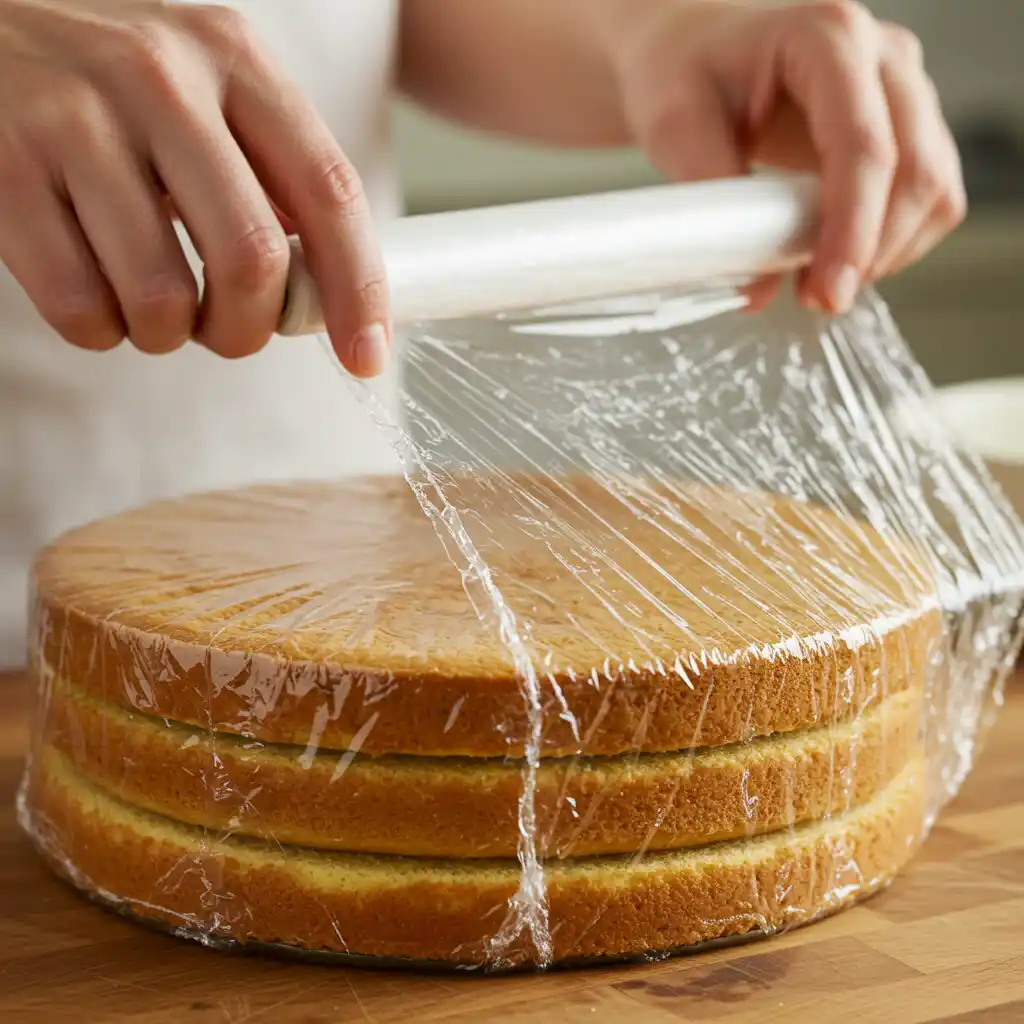
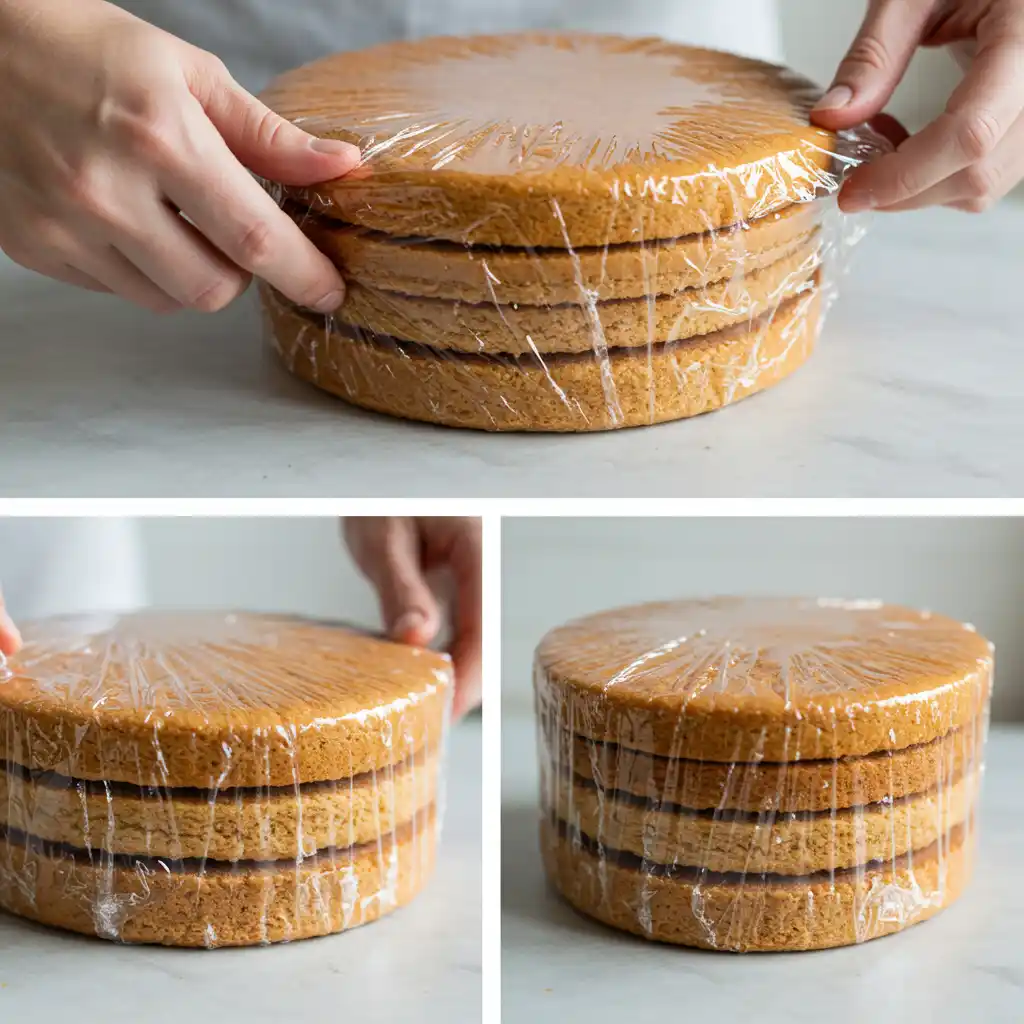
Smart tip:
Wrap individual slices separately to make them grab-and-go, while also protecting them from drying out.
Part 3: Refrigeration When It’s Necessary and How to Do It Right
Which Cakes Should Always Be Refrigerated
One of the most misunderstood cake storage hacks involves the refrigerator. While many cakes don’t need chilling, some absolutely must be refrigerated to avoid spoilage.
Here’s a quick checklist of cakes that should always go in the fridge:
- Cakes with cream cheese frosting (like red velvet or carrot cake)
- Whipped cream cakes
- Custard-filled cakes
- Cakes with fresh fruit toppings or fillings
- Tres leches cakes
- No-bake cheesecakes
Why? These ingredients are highly perishable and can quickly go bad at room temperature, especially in warm or humid environments. Storing them in the fridge helps maintain texture, flavor, and safety.
How to Keep Cakes Moist in the Fridge
Refrigerating a cake doesn’t have to dry it out. One of the smartest cake storage hacks is mastering the art of sealing in moisture. Here’s how to do it right:
Step-by-step guide:
- Let the cake cool completely. Never refrigerate a warm cake it will sweat and get soggy.
- Wrap the cake tightly in plastic wrap. For frosted cakes, chill them uncovered for 15 minutes to harden the icing, then wrap them.
- Use an airtight container. This prevents air from drying the cake out.
- Store it on a fridge shelf (not the door). This maintains a stable temperature.
- For extra moisture, place a slice of white bread in the container (not touching the cake). The bread will absorb any drying air, keeping the cake softer longer.
| Mistake | What Happens | Storage Hack |
|---|---|---|
| Storing without wrapping | Cake dries out quickly | Always double-wrap in plastic or foil |
| Placing next to strong odors | Cake tastes weird | Store in a sealed cake container |
| Refrigerating warm cake | Turns sticky or soggy | Cool completely before refrigerating |
Does Refrigerating Cake Dry It Out?
A common myth is that refrigeration kills cake texture. And yes, if done carelessly, that’s true. But one of the most underrated cake storage hacks is this: it’s not the fridge it’s the air.
Airflow is what causes the cake to lose moisture, not the cold itself. That’s why airtight wrapping and containers are non-negotiable. If your cake is properly sealed, it can stay moist in the fridge for up to 5 days, especially if it’s rich in fat (like butter cakes).
Learn more about Why Cakes Go Stale and How to Prevent It to improve your baking game.
Freezing Cakes Like a Pro Dos and Don’ts
When Should You Freeze a Cake?
Freezing is one of the most underrated cake storage hacks, especially if you need to prep desserts ahead of time or save leftovers without waste. But not every cake is freezer-friendly.
Freeze your cake when:
- You’re baking in advance for an event
- You have leftover slices you won’t eat within 3–5 days
- You want to preserve freshness for frosted cakes
- You want to make celebration cakes in bulk
Avoid freezing if the cake:
- Has delicate fresh fruit or meringue toppings
- Is filled with whipped cream (which can separate)
- Contains gelatin-based elements (which can become rubbery)
How to Freeze a Cake the Right Way
Freezing a cake is easy if you know the right steps. Done correctly, it can taste as fresh as the day it was baked. Here’s one of the most essential cake storage hacks you’ll ever use:
Freezing Unfrosted Cake Layers:
- Let cake layers cool completely.
- Wrap each layer tightly in plastic wrap.
- Wrap again in foil to prevent freezer burn.
- Label with the date.
- Place in a freezer-safe zip-top bag or airtight container.
Freezing Frosted Cakes or Slices:
- Place the cake (or slice) in the freezer for 1–2 hours uncovered until the frosting hardens.
- Wrap it tightly in plastic wrap, followed by foil.
- Store it in a container or bag for double protection.
| Type of Cake | Freezes Well? | Notes |
|---|---|---|
| Butter cake | ✅ | Wrap tightly for best texture |
| Pound cake | ✅ | Holds shape well in freezer |
| Cheesecake | ✅ | Freeze without toppings |
| Angel food | ❌ | Texture suffers |
| Cakes with fruit filling | ⚠️ | Wrap with care freeze short term |
Can You Freeze Cake in Tupperware?
Yes you absolutely can! In fact, using Tupperware or any airtight plastic container is one of the most practical cake storage hacks to prevent freezer burn and preserve flavor. Just be sure the cake is fully wrapped in plastic wrap before placing it in the container. This double barrier ensures freshness, especially for delicate frostings or moist textures.
Bonus Tips:
- Leave headroom. Cakes expand slightly as they freeze.
- Avoid glass containers. They may shatter with sudden temperature changes.
- Use square or rectangular containers. They waste less freezer space and provide a snug fit.
How Long Can Frozen Cake Last?
Frozen cakes, when properly wrapped, can last up to 3 months without losing flavor. Some dense cakes, like pound or butter cakes, can go even longer. But for best taste and texture, try to use them within that 3-month window.
To thaw, move the cake from freezer to fridge for several hours (or overnight), without unwrapping it this prevents condensation from making the cake soggy. Then bring it to room temperature before serving.
Covering Cakes for Storage—Best Practices to Keep Your Cake Fresh
Why Proper Cake Covering Is a Key Cake Storage Hack
One of the simplest yet most effective cake storage hacks is covering your cake properly. A cake left exposed to air will dry out quickly, lose flavor, and attract unwanted odors. Whether you’re storing a frosted cake, a plain cake, or cake slices, the right cover keeps moisture locked in and protects your dessert.
Proper covering not only preserves texture but also helps avoid fridge odors soaking into the cake. This tip is especially crucial when storing cakes with delicate frostings or fillings.
How to Cover a Cake for Storage
Here are some popular and reliable methods to cover cakes for storage:
Plastic Wrap
- Wrap the cake tightly with plastic wrap to seal in moisture.
- For frosted cakes, chill the cake first so the wrap doesn’t stick to the frosting.
- For layered cakes, wrap each layer individually before stacking to avoid smudging.
Aluminum Foil
- Use heavy-duty foil for wrapping cakes without frosting.
- It provides a barrier against freezer burn if freezing the cake.
- Foil can also be used over plastic wrap for extra protection.
Cake Domes and Storage Containers
- Cake domes are excellent for short-term storage on the counter.
- Airtight cake containers or Tupperware work well for refrigerated or room temperature storage.
- Ensure the container is tall enough so the frosting isn’t crushed.
Tips for Covering Different Types of Cakes
- Buttercream Frosted Cakes: Chill before wrapping in plastic to avoid sticking.
- Fondant Cakes: Cover loosely with a dome to prevent sweating.
- Naked or Semi-Naked Cakes: Cover with a loose foil tent to allow airflow but protect from drying out.
- Sponge Cakes: Wrap tightly to lock in moisture.
Common Mistakes to Avoid When Covering Cakes
- Wrapping warm cakes can cause condensation and sogginess.
- Using loose covers that let air in defeats the purpose of covering.
- Applying plastic wrap directly to delicate frostings without chilling can ruin the decoration.
- Storing cakes near strong-smelling foods without protection can cause flavor transfer.
Properly covering your cake is a foundational cake storage hack that helps maintain taste and texture, whether you’re storing it for hours or days.
Refrigeration Tips When and How to Chill Cakes Without Drying Them Out
Understanding When Refrigeration Is the Right Cake Storage Hack
Refrigerating cake can be tricky. While it’s often necessary for cakes with perishable fillings or frostings, improper refrigeration is one of the biggest pitfalls to avoid in your cake storage hacks because it can leave your cake dry and crumbly. Knowing when to refrigerate and how to do it properly is a vital cake storage hack to keep your dessert moist and flavorful.
When to refrigerate cakes:
- Cakes with cream cheese, fresh cream, or custard fillings
- Cakes decorated with buttercream or whipped cream that won’t hold up well at room temperature
- Cakes that will be stored for more than two days in a warm climate
When not to refrigerate:
- Simple butter or pound cakes without perishable toppings
- Cakes that dry out easily, like sponge cakes, unless wrapped well
How to Refrigerate Cake Properly to Prevent Drying Out
Follow these important cake storage hacks to avoid the fridge’s drying effects:
- Wrap your cake tightly using plastic wrap or airtight containers to prevent exposure to cold, dry air.
- Use cake boxes or domes as extra layers of protection, preventing your cake from absorbing fridge odors.
- Chill frosting or glaze before wrapping to avoid damage—this is a smart cake storage hack for delicate finishes.
- Avoid storing cakes near strong-smelling foods, since cakes can easily absorb odors that ruin their flavor.
Don’t miss our Ultimate Guide to Refrigerating Cakes for detailed tips and tricks that are key cake storage hacks.
How Does Refrigerating Cake Affect Moisture?
Refrigeration can cause moisture loss, making cakes dry and crumbly if not stored properly. This happens because cold air draws moisture out of the cake. Using airtight seals is one of the most effective cake storage hacks to combat this problem. Additionally, cakes with high-fat content tend to tolerate refrigeration better than lean cakes.
How to Re-Moisturize Cake After Refrigeration
If your cake has dried out, don’t worry here are some easy cake storage hacks to bring back moisture:
- Brush the cake layers lightly with simple syrup or flavored syrup before serving.
- Serve with fresh whipped cream or fruit to add moisture contrast.
- Warm slices briefly in the microwave to soften texture, another useful cake storage hack.
Best Practices for Storing Frostings and Fillings to Keep Cakes Delicious
Why Proper Storage of Frostings and Fillings Is an Essential Cake Storage Hack
Many cakes owe their flavor and texture to their frostings and fillings. Improper storage can dry out, spoil, or ruin these elements, negatively affecting the cake’s overall quality. Knowing how to store frostings and fillings correctly is one of the most important cake storage hacks to keep your desserts tasting fresh and moist.
Types of Frostings and Their Storage Needs
- Buttercream: Generally stable at room temperature for up to two days, but longer storage requires refrigeration. Store buttercream in airtight containers to avoid drying out and absorbing odors—a crucial cake storage hack.
- Cream Cheese Frosting: Must be refrigerated due to its dairy content and consumed within 3–4 days to ensure safety and freshness.
- Whipped Cream: Highly perishable, whipped cream needs refrigeration and should be used within 24 hours.
- Fondant: Can be stored at room temperature in airtight containers away from humidity; refrigeration can cause sweating and texture changes.
- Ganache: Can be refrigerated or stored at room temperature depending on consistency and ingredients—another flexible cake storage hack.
How to Store Cake Fillings Properly
Cake fillings vary widely, from jams and curds to custards and mousses, each requiring specific care:
- Fruit jams and preserves: Store in a cool, dark place and refrigerate after opening.
- Custards and mousses: Always refrigerate and consume within 1–2 days to avoid spoilage.
- Nut pastes and creams: Store in airtight containers at room temperature or refrigerate depending on ingredients and shelf life.
Tips for Storing Frosted Cakes with Fillings
- Always chill cakes with perishable fillings and frostings to prevent spoilage—this is a must-follow cake storage hack.
- Use airtight cake domes or wrap cakes well with plastic wrap to protect from drying out and fridge odors.
- When freezing, consider freezing unfrosted cake layers and frosting separately to maintain the best texture and flavor—a smart cake storage hack for long-term storage.
Looking for inspiration? Try How to Store Frostings and Fillings Properly for expert advice and detailed cake storage hacks.
Does Buttercream Need to Be Refrigerated?
Buttercream is one of the most common frostings used on cakes. While it can sit at room temperature for short periods, refrigeration is recommended for longer storage, especially in warm or humid climates. When refrigerated, wrap the cake properly to avoid drying out the frosting, an essential cake storage hack to keep your cake looking and tasting great.
Common Cake Storage Mistakes to Avoid for Longer Freshness
Why Avoiding Mistakes Is Crucial for Effective Cake Storage Hacks
Even with the best intentions, many people unknowingly make mistakes that shorten their cake’s freshness. Understanding what not to do is just as important as knowing the right storage techniques. Avoiding common pitfalls ensures your cake stays moist, flavorful, and appealing longer.
Mistake 1: Storing Cake Without Proper Covering
Leaving a cake uncovered exposes it to air, causing it to dry out quickly. This is one of the biggest blunders in cake storage. Always use airtight containers, plastic wrap, or cake domes as part of your cake storage hacks to lock in moisture.
Mistake 2: Refrigerating Cake Without Protection
Placing a cake directly into the fridge without wrapping it can dry it out and cause it to absorb fridge odors. Proper wrapping with plastic or storing in airtight containers is essential to prevent this.
Mistake 3: Freezing Cake Incorrectly
Freezing cake improperly can lead to freezer burn or texture changes. Wrap cakes tightly in plastic wrap and aluminum foil, or use airtight freezer-safe containers. Label with date to avoid long-term freezer storage that affects quality.
Mistake 4: Storing Cake Near Strong Odors
Cakes can easily absorb smells from the fridge or storage area, ruining their flavor. Keep cakes away from onions, garlic, or other pungent foods, and use sealed containers as a barrier.
Mistake 5: Not Considering Cake Type
Different cakes need different storage approaches. For example, a dense chocolate cake stores differently than a light chiffon cake. Applying one-size-fits-all storage can lead to disappointing results.
Mistake 6: Frosting and Cake at Different Temperatures
Storing frosted cakes at fluctuating temperatures can cause condensation, making frosting soggy and cake soggy or dry. Keep cakes in consistent conditions and avoid frequent temperature changes.
FAQ and Final Tips for Mastering Cake Storage Hacks
Frequently Asked Questions About Cake Storage Hacks
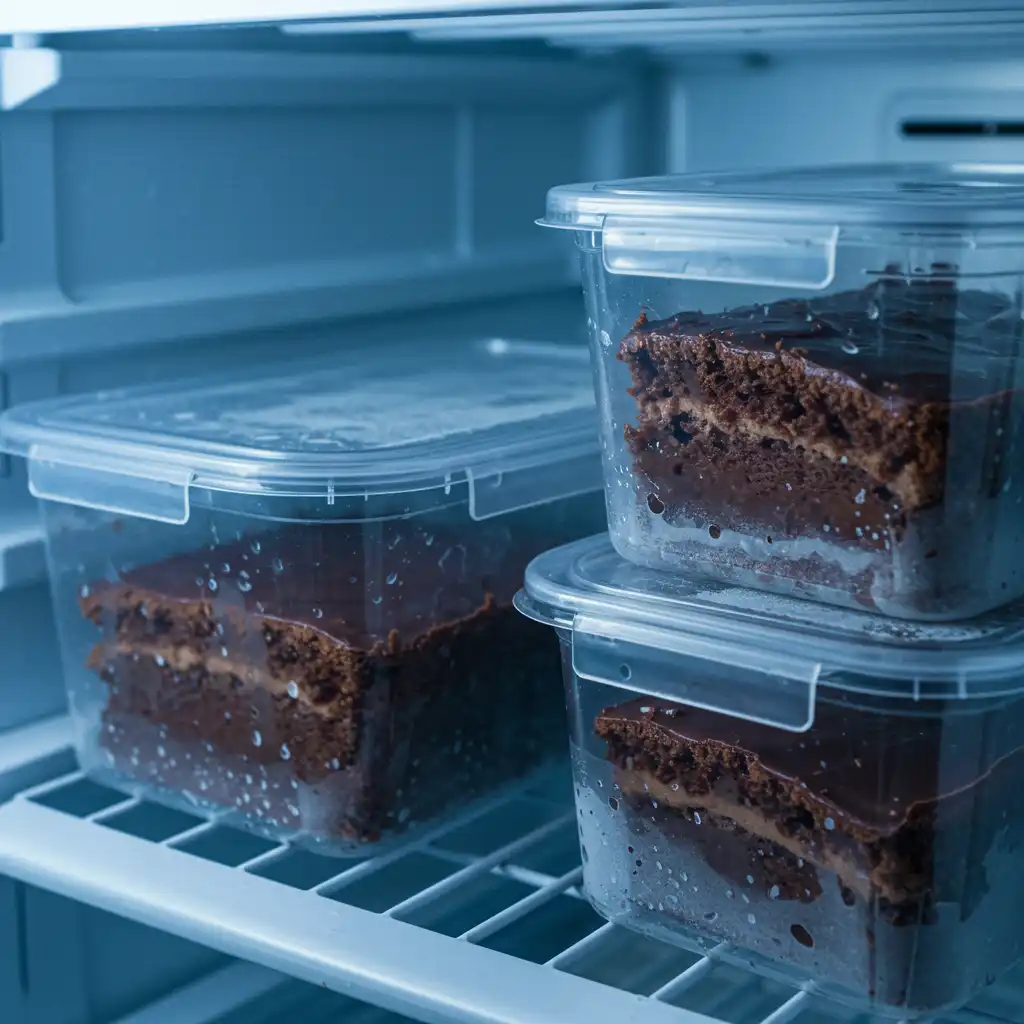
How to keep a cake moist overnight?
To keep a cake moist overnight, cover it tightly with plastic wrap or store it in an airtight container at room temperature. Avoid refrigerating unless necessary, as cold air can dry the cake out.
Can you store cake in Tupperware?
Yes, storing cake in Tupperware or any airtight container is a practical cake storage hack. It helps preserve moisture and protects the cake from external odors.
Does refrigerating cake dry it out?
Refrigeration can dry out cake if not stored properly. Always wrap the cake or use an airtight container to prevent moisture loss when chilling.
What makes cake spoil fast?
Factors like exposure to air, heat, humidity, and perishable fillings cause cakes to spoil quickly. Proper storage methods are essential to slow down spoilage.
How do you make cake moist again after being in the fridge?
Brush the cake layers with simple syrup or flavored syrup before serving to restore moisture. Serving with whipped cream or fruit also helps.
What kind of cake does not need to be refrigerated?
Cakes without perishable fillings or frostings, such as pound cake or fruitcake, generally do not require refrigeration if consumed within a few days.
How long does it take for a cake to get spoiled?
At room temperature, most cakes spoil in 2-3 days, while refrigerated cakes last about 5-7 days depending on ingredients.
Does buttercream need to be refrigerated?
Buttercream can be stored at room temperature for a day or two, but refrigeration is recommended for longer storage to prevent spoilage.
How to cover a cake for storage?
Use plastic wrap, foil, or an airtight cake container. Cake domes are great for keeping cakes covered while on display.
Can I bake a cake the night before and frost it next day?
Absolutely. Baking a cake the night before and frosting it the next day is a common cake storage hack that saves time and often results in easier frosting application.
Can you freeze cake in Tupperware?
Yes, cakes can be frozen in airtight Tupperware containers. Make sure to wrap the cake well to prevent freezer burn and maintain freshness.
Did You Try Our Recipe?
There are no reviews yet. Be the first one to write one.



